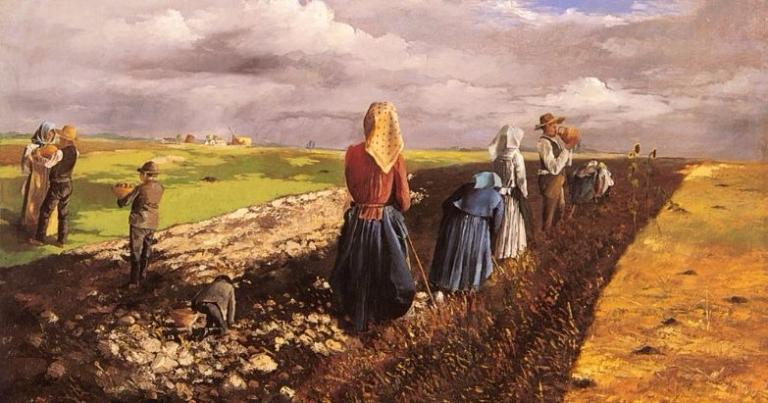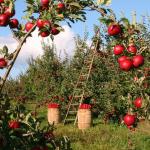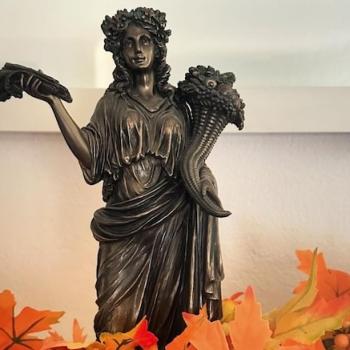I love Autumn, it’s my favorite season, but it’s far too early to reflect on falling leaves, pumpkin patches, and mulled cider. September also lacks the riot of color that often occurs in mid-October, but it posses a dignity and beauty all its own in its golden wheat fields and ocean blue skies. The Equinox is the first chapter of Fall, not the middle of the book.
Despite just being the prologue, The Autumnal Equinox remains one of my favorite sabbats. I’ll put it right up there next to Beltane, Samhain, and Yule. A lot of sabbats feel rather inter-changeable. I’ve written Ostara rituals that with only a few tweaks could easily be turned into effective Beltane rites, the same with Midsummer and Lughnassa. On the surface I should be able to do the same thing with the Fall Equinox and Samhain, they are both harvest festivals after all, but to me they’ve become quite distinct holidays.

Samhain’s harvest associations remain obviously, but they are often over-shadowed by the closeness of the “veil between the worlds.” It’s almost impossible to remove Samhain from the context of ancestors and relatives who have passed on. That’s not a complaint, I love the feeling of reunion I get at Samahin with lost loved ones, but that’s become such a large part of the sabbat that almost everything else about it gets lost. I love a good harvest ritual, which is why this is one of my favorite times of the year.
One thing I truly appreciate about this particular sabbat is that it’s not a “made up” holiday. Many holidays have rather dubious origins, but September celebrations are legitimately old. Bede, writing in the early 700’s CE, mentions September as an Anglo-Saxon holy month when the harvest was celebrated. By the late 1500’s the English countryside celebrated the harvest with Harvest Home, a time for feasting, celebration and games. While it’s nearly impossible to prove that Renaissance-era customs date back to pagan antiquity in an unbroken chain, many of the ways Harvest Home was celebrated “feel Pagan,” which is more than enough to make them so in my mind.
Harvest Kings and Queens were popular in many areas, often times the “royalty” getting to act as supervisors for the gathering and gleaning respectively. Not surprisingly, feasting often ended a long day of toil in the fields. Customs honoring the last sheaf of grain to be gathered were common. Sometimes the last of the harvest was seen as a positive talisman, and depending on the location, it could also be looked at with a degree of foreboding. The last bit of crop left standing in the field was often harvested from a distance with men throwing sickles to bring it down. Generally it was all just good-hearted fun, but some folklorists have attributed this custom to fear, that no one wanted to be the last man to cut down the crop.

Parades lead by someone carrying that last bit of grain to be harvested were popular, as were parades featuring corn dollies made from those final sheaves. It’s impossible to know exactly what the corn dollies symbolized to various communities. They were often given names and titles, with “Crone” being particularly popular. Some of them were given seats of honor during the feasting. It’s easy to see a goddess in those dollies, though it’s impossible to know if such customs truly come from an ancient paganism or are simply seasonal rites that feel Pagan today. Regardless, they do illustrate a close relationship with the Earth, which I’ll always feel comfortable celebrating.
You might have noticed that I have refrained from using the term “Mabon” in these first 650 words, and that was a challenge. Mabon was originally the name of a Welsh god (or hero) and was only attached to the Fall Equinox back in 1970 by (our own) Aiden Kelly. There are many in the Pagan Community who dislike the term Mabon as it’s not authentic, but I still find myself oddly attached to it. Mabon literally translates as “Son of the Mother,” which does seem like a strange thing to name a holiday after, but the word Mabon seems firmly wedded to the Autumnal Equinox forty years in.
I lived in a college town long past the time I was in college and the rhythms of Michigan State University played a large role in my Pagan practice. September was never the beginning of the end, in a lot of ways it was always the “beginning of the beginning.” I was involved with the college student group for ages (later as an advisor), and September was when we kicked off a new year of rituals, activities, parties, and everything else. Since it was the start of the school semester, the Autumn Equinox was often our biggest sabbat of the year. Giant potluck dinners, a big party atmosphere, and often a great scavenger hunt type ritual taking place over two square city miles, it was always about as perfect of a six hours as could ever be hoped for. Those were great times, and have contributed to the rose colored glasses I view this time of year through.
The equinox’s lack of association with anything beyond the harvest and even night and day has allowed it to become the amazing, laid-back Pagan Thanksgiving it was meant to be. Post-Samhain Ritual I tend to be far too drained to do anything other than melt into a chair, and my dinner beforehand is usually eaten in silence, sometimes in the dark. There’s a lightness to this particular sabbat, and a lack of expectation that opens up possibilities. I like ritual to be serious and have some meaning, but not every ritual has to hit you over the head with what it’s trying to say. Harvest Home* is summed up in its name; post-summer everyone has returned from their various journeys and it’s time to celebrate another year of the Earth’s abundance. We’re home and it’s harvest time.
Yes, for many of us, the nights grow colder and the blooms on the flowers begin to fade, but there’s always been an amazing energy in the air this time of year. Summer’s door closes and Autumn’s opens wide. Yes, it’s too early to wax nostalgic about frosty mornings, pumpkins, and the crunch of leaves under my boots, but it is a great time to celebrate the transition of the Earth and the gathering of the harvest.
*Before moving to California I’m not sure I had ever even heard the term “Harvest Home” before, but it’s a phrase attached to a few Equinox rituals out here.

















